Microsoft Outlook is one of the most extensively used email clients. It is used by many business organizations and independent and naïve users. If you are an MS Outlook user, then it is undeniable that you might have come across different kinds of errors. These errors can pop up due to many reasons like Outlook profile corruption, PST corruption, PST file corruption, relocation of the PST file, etc. Out of all the errors being thrown by this application, one of the most common is error 0x8004010F.
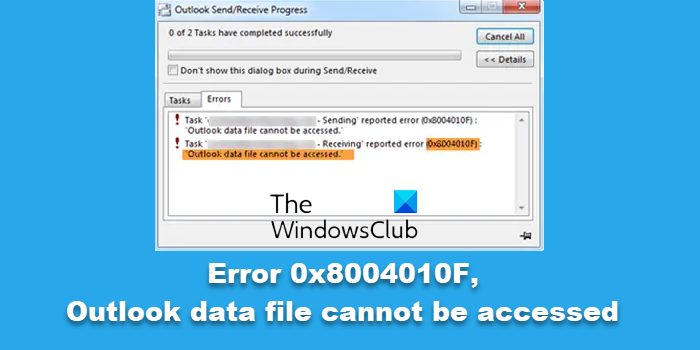
Error 0x8004010F, Outlook data file cannot be accessed
When you try to send or receive emails in Microsoft Outlook, you may receive one of these error messages:
- 0x8004010F: Outlook data file cannot be accessed OR
- 0x8004010F: The operation failed. An object could not be found
This error occurs on Outlook 2010 and Outlook 2013 versions due to the corruption of the Outlook profile. Typically, it doesn’t allow the application to send or receive email messages.
What is causing this 0x8004010F error?
A few certain causes which prevent Outlook from sending or receiving emails comprise:
- Outlook data files (.pst) are located at the wrong place
- Outlook data files are moved to a different location
- Post upgrade the current Outlook profile gets corrupted
- Outlook profile is not tested properly.
Since this error will prohibit you to send/receive any emails, resolving it at the earliest should be your priority.
How to fix the Outlook error 0x8004010F
Depending upon the real reason behind the error, users need to opt for different ways to fix this Outlook error. Here are a few fixes that can help.
- Create a new Outlook profile
- When making a new Outlook profile is not possible
Let’s look at these options in more detail.
1] Create a new Outlook profile
When the cause behind the error is a corrupted Outlook profile, making a new one can fix the error. To resolve Outlook error 0x8004010F, you will need to recognize the current location of your default Outlook data file, and then make a new Outlook profile and set it default. Here’s how to do this:
Step 1 – Locate the default Outlook data file
1. From the ‘Start Menu’ open ‘Control Panel’
2. Click ‘Mail’ to open the ‘Mail Setup – Outlook’ dialog box
3. In the ‘Mail Setup – Outlook’ dialog box click ‘Show Profiles’.
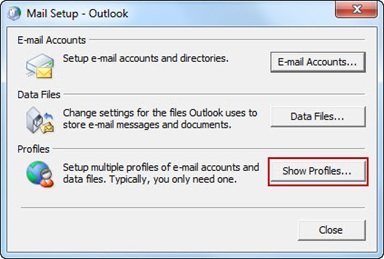
4. Select your current Outlook Profile and hit ‘Properties’.
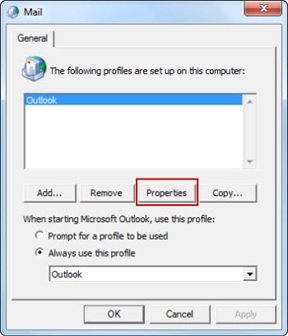
5. Again, in the ‘Mail Setup – Outlook’ dialog click ‘Data Files’ to open the ‘Account Settings’ dialog.
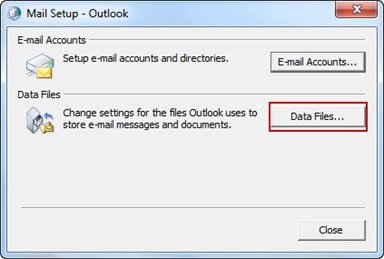
6. Click on the ‘Data Files’ tab. Now note the name and location of the default Outlook profile. Please note, the default profile will be represented by a checkmark.
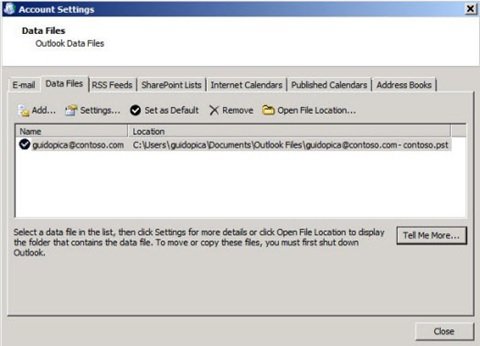
7. Click ‘Close’ to exit
Step 2 – Create a new Outlook Profile
You can create Outlook profiles in two ways, one Use auto account set up to create an IMAP or POP3 email account or manually create an IMAP or POP3 email account.
- Option A: Auto-setup IMAP or POP3 email account
- Option B: Manually create IMAP or POP3 email account.
Below we list the steps for both the options:
Option A – Auto-setup IMAP or POP3 email account:
1. Go to ‘Control Panel’ and click ‘Mail’ to open the ‘Mail Setup – Outlook’ dialog
2. In the new dialog box click ‘Show Profiles’.
3. Select your current Outlook profile and then hit ‘Add’.
4. In the ‘New Profile’ dialog box, type a name for the new profile and click ‘OK’
5. This will open the ‘Add New Account’ dialog box
6. Input your email information and click ‘Next’ to configure the new profile
7. Once configuration completes, click on ‘Finish’.
Option B – Manually create IMAP or POP3 email account:
1. Go to ‘Control Panel’ and click ‘Mail’ to open the ‘Mail Setup – Outlook’ dialog
2. In the new dialog box click ‘Show Profiles’.
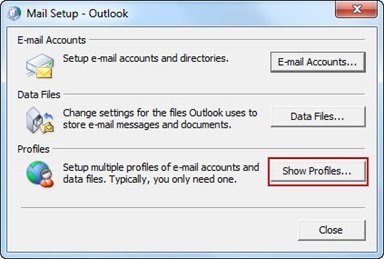
3. Select your current Outlook profile and then hit ‘Add’.
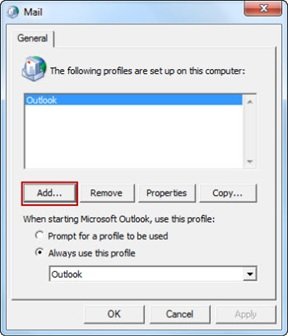
4. In the ‘New Profile’ dialog box, type a name for the profile and click ‘OK’
5. This will open the ‘Add New Account’ dialog box, here select ‘Manually configure server settings or additional server types’ and click ‘Next’.
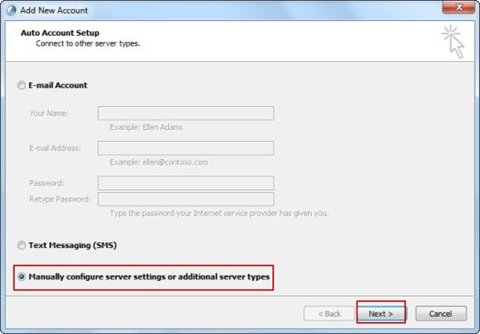
6. Now in the ‘Choose Service’ dialog box, select ‘Internet E-mail’ and click ‘Next’
7. In the ‘Internet E-mail settings’ dialog manually your account details
8. Click ‘Test Account Settings’ to examine your account
9. Now select the ‘Existing Outlook Data File’ option and click ‘Browse’ to open the ‘Open Outlook Data File’ dialog.
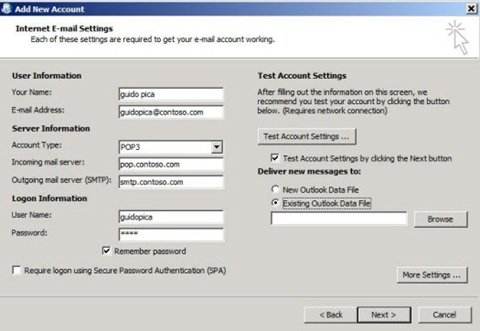
10. Find and select the Outlook data file you located previously
11. Follow path OK -> Next -> Close -> Finish.
Step 3 – Configure the new Outlook profile as the default
This is the final step for this fix:
- Go to ‘Control panel’ and click ‘Mail’
- Now click on ‘Show Profiles’ in the Mail Setup – Outlook
- In the ‘Mail’ window select the newly created profile and click ‘Properties’
- In the Mail Setup windows, click on ‘Email Accounts’
- In the Account Settings window, go to ‘Data File’ and hit ‘Set as Default’
- Click ‘Close’.
The new Outlook data file is now created, and should in all probabilities work without any problems.
Read: How to add someone to Safe Senders List in Outlook
2] When making a new Outlook profile is not possible
Few users have many email accounts in Outlook and creating a new profile may not be feasible for them. In such a case, you can fix the error by changing the message delivery location to a temporary folder and then changing it back. Follow these steps to fix error 0x8004010F:
- From Outlook application, follow this path File -> Account Settings
- Click ‘Change Folder’ and expand it by clicking on the ‘+’ sign
- Select ‘Inbox’ and hit the ‘New Folder’ option to create a new temporary folder
- Type a name for the folder and click ‘OK’
- Select the newly created folder and hit ‘OK’. The message delivery location will now show this new folder
- Now alter the temporary folder back to the original location. To do this click on ‘Change Folder’ once again
- Hit ‘Inbox’ and then click ‘OK’
- Close ‘Account Settings’ and click ‘Send/Receive’.
This may fix the error.
These were some well-known methods to resolve the Outlook error 0x8004010F. We hope you found these tips useful and, consequently, use them to fix the error and get an uninterrupted usage of Microsoft Outlook.
Read: Emails not automatically Sent or Received at startup in Outlook.
Leave a Reply